A Ten-Year Record Shows Warming Inside the Belize Barrier Reef Lagoon
Abstract
1. Introduction
2. Materials and Methods
2.1. Study Site
2.2. Long-Term Recording at One Station
2.3. Short-Term Synchronous Recording of Tide and Temperature at Four Depths
2.4. Comparative Data
2.5. Satellite Data
3. Results
3.1. Ten Year Temperature Record
3.2. Temperature Record and Coral Bleaching
3.3. Mean Annual Temperatures
3.4. Mean Monthly Temperatures
3.5. Comparative Temperature at Different Depths
3.6. Comparative Temperature between Satellite Data and In Situ Logger
4. Discussion
5. Conclusions
Supplementary Materials
Author Contributions
Funding
Data Availability Statement
Acknowledgments
Conflicts of Interest
References
- Hoegh-Guldberg, O. Climate change, coral bleaching and the future of the world’s coral reefs. Mar. Freshw. Res. 1999, 50, 839–866. [Google Scholar] [CrossRef]
- Wilkinson, C.; Souter, D. Status of Caribbean Coral Reefs after Bleaching and Hurricanes in 2005; Global Coral Reef Monitoring Network, and Reef and Rainforest Research Centre: Townsville, Australia, 2008; 152p. [Google Scholar]
- Castillo, K.D.; Ries, J.B.; Weiss, J.M.; Lima, F.P. Decline of fore reef corals in response to recent warming linked to history of thermal exposure. Nat. Clim. Chang. 2012, 2, 756–760. [Google Scholar] [CrossRef]
- Walker, Z. South Water Cay Reserve Management Plan 2010–2015; Wildtracks Report; WildTracks: La Isla Rd, Belize, 2009; 270p. [Google Scholar]
- Chollett, I.; Mumby, P.J.; Müller-Karger, F.E.; Chuanmin, H. Physical environments of the Caribbean Sea. Limnol. Oceanogr. 2012, 57, 1233–1244. [Google Scholar] [CrossRef]
- Lobel, P.S.; Lobel, L. Endemic marine fishes of Belize: Evidence of isolation in a unique ecological region. In Too Precious to Drill: The Marine Biodiversity of Belize; Palomares, M.L.D., Pauly, D., Eds.; Fisheries Centre Research Reports; Fisheries Centre, University of British Columbia: Kelowna, BC, USA, 2011; Volume 19, pp. 48–51. [Google Scholar]
- Smale, D.A.; Wernberg, T. Satellite-derived SST data as a proxy for water temperature in nearshore benthic ecology. Mar. Ecol. Prog. Ser. 2009, 387, 27–37. [Google Scholar] [CrossRef]
- Baumann, J.H.; Townsend, J.E.; Courtney, T.A.; Aichelman, H.E.; Davies, S.W.; Lima, F.P.; Castillo, K.D. Temperature regimes impact coral assemblages along environmental gradients on lagoonal reefs in Belize. PLoS ONE 2016, 11, e0162098. [Google Scholar] [CrossRef] [PubMed]
- Koltes, J.H.; Opishinski, T.B. Patterns of water quality and movement in the vicinity of Carrie Bow Cay, Belize. Smithson. Contrib. Mar. Sci. 2009, 38, 379–390. [Google Scholar]
- Aronson, R.; Precht, W.; Toscano, M.; Koltes, K. The 1998 bleaching event and its aftermath on a coral reef in Belize. Mar. Biol. 2002, 141, 435–447. [Google Scholar]
- Helmuth, B.; Leichter, J.J.; Rotjan, R.D.; Castillo, K.D.; Fieseler, C.; Jones, S.; Choi, F. High resolution spatiotemporal patterns of seawater temperatures across the Belize Mesoamerican Barrier Reef. Sci. Data 2020, 7, 396. [Google Scholar] [CrossRef]
- Greer, L.; Curran, H.A.; Wirth, K.; Humston, R.; Johnson, G.; McManus, L.; Stefanic, C.; Clark, T.; Lescinsky, H.; Forman-Castillo, K. Coral Gardens Reef, Belize: An Acropora spp. Refugium under threat in a warming world. PLoS ONE 2023, 18, e0280852. [Google Scholar] [CrossRef]
- Castillo, K.D.; Lima, F.P. Comparison of in situ and satellite-derived (MODIS-Aqua/Terra) methods for assessing temperatures on coral reefs. Limnol. Oceanogr. Methods 2010, 8, 107–117. [Google Scholar] [CrossRef]
- McField, M.; Bood, N.; Fonseca, A.; Arrivillaga, A.; Franquesa Rinos, A.; Loreto Viruel, R. Status of the Mesoamerican Reef after the 2005 coral bleaching event. In Status of Caribbean Coral Reefs after Bleaching and Hurricanes in 2005; Wilkinson, C., Souter, D., Eds.; Global Coral Reef Monitoring Network, and Reef and Rain- Forest Research Centre: Townsville, Australia, 2005; pp. 45–60. [Google Scholar]
- Alemu, I.; Clement, J.B.; Mass, Y. Coral Bleaching in 2010 in the Southern Caribbean. PLoS ONE 2014, 9, e83829. [Google Scholar] [CrossRef] [PubMed]
- Baumann, J.H.; Ries, J.B.; Rippe, J.P.; Courtney, T.A.; Aichelman, H.E.; Westfield, I.; Castillo, K.D. Nearshore coral growth declining on the Mesoamerican Barrier Reef System. Glob. Chang. Biol. 2019, 25, 3932–3945. [Google Scholar] [CrossRef] [PubMed]
- Glenn, E.; Comarazamy, D.; González, J.E.; Smith, T. Detection of recent regional sea surface temperature warming in the Caribbean and surrounding region. Geophys. Res. Lett. 2015, 42, 6785–6792. [Google Scholar] [CrossRef]
- Hayes, R.L.; Goreau, T.J. Satellite-derived sea surface temperature from Caribbean and Atlantic coral reef sites, 1984–2003. Rev. Biol. Trop. 2008, 56 (Suppl. S1), 97–118. [Google Scholar] [CrossRef][Green Version]
- Alves, C.; Valdivia, A.; Aronson, R.B.; Bood, N.; Castillo, K.D.; Cox, C.; Fieseler, C.; Locklear, Z.; McField, M.; Mudge, L.; et al. Twenty years of change in benthic communities across the Belizean Barrier Reef. PLoS ONE 2022, 17, e0249155. [Google Scholar] [CrossRef]
- Aronson, R.B.; Precht, W.F.; MacIntyre, I.G.; Murdock, T.J.T. Coral bleach-out in Belize. Nature 2000, 405, 36. [Google Scholar] [CrossRef]
- Peckol, P.M.; Curran, H.A.; Floyd, E.Y.; Robbart, M.L.; Greenstein, B.J.; Buckman, K.L. Assessment of selected reef sites in Northern and Southern Belize, including recovery from bleaching and hurricane disturbances (Stony corals, algae and fish). In J.C. Lang (ed.), Status of coral reefs in the western Atlantic: Results of initial Surveys, Atlantic and Gulf Rapid Reef Assessment (AGRRA) Program. Atoll Res. Bull. 2003, 496, 146–171. [Google Scholar]
- Di Santo, V.; Lobel, P.S. Size affects digestive responses to increasing temperature in fishes: Physiological implications of being small under climate change. Mar. Ecol. 2016, 37, 813–820. [Google Scholar] [CrossRef]
- Di Santo, V.; Lobel, P.S. How to beat the heat: Body size affects thermal tolerance in tropical gobies. J. Expl. Mar. Biol. Ecol. 2017, 487, 11–17. [Google Scholar] [CrossRef]
- Anton, A.; Randle, J.L.; Garcia, F.C.; Rossbach, S.; Ellis, J.I.; Weinzierl, M.; Duarte, C.M. Differential thermal tolerance between algae and corals may trigger the proliferation of algae in coral reefs. Glob. Chang. Biol. 2020, 26, 4316–4327. [Google Scholar] [CrossRef]
- McField, M.D. Coral response during and after mass bleaching in Belize. Bull. Mar. Sci. 1999, 64, 155–172. [Google Scholar]
- Pezold, F.; van Tassell, J.; Tornabene, L.; Aiken, K.A. Elacatinus lobeli. The IUCN Red List of Threatened Species. 2015. Available online: https://www.iucnredlist.org/species/187435/46944387 (accessed on 1 November 2016).
- van Tassell, J.; Pezold, F.; Tornabene, L.; Aiken, K.A.; Bouchereau, J.-L. Elacatinus colini. The IUCN Red List of Threatened Species. 2015. Available online: https://www.iucnredlist.org/species/187435/46944387 (accessed on 1 November 2016).
- Rocha, L.A. Halichoeres socialis. The IUCN Red List of Threatened Species. 2015. Available online: https://www.iucnredlist.org/species/187435/46944387 (accessed on 1 November 2016).
- Moran, B.; Puebla, O. Hypoplectrus maya. The IUCN Red List of Threatened Species. 2020. Available online: https://www.iucnredlist.org/species/187435/46944387 (accessed on 1 November 2016).
- Randall, J.E.; Lobel, P.S. Halichoeres socialis, a new labrid fish from Belize, Caribbean. Copeia 2003, 2003, 124–130. [Google Scholar] [CrossRef]
- Lobel, P.S. A review of the hamlets (Serranidae, Hypoplectrus) with description of two new species. Zootaxa 2011, 3096, 1–17. [Google Scholar] [CrossRef]
- Randall, J.E.; Colin, P.L. Elacatinus lobeli, a new cleaning goby from Belize and Honduras. Zootaxa 2009, 2173, 31–40. [Google Scholar] [CrossRef]
- Moran, B.M.; Hench, K.; Waples, R.S.; Höppner, M.P.; Baldwin, C.C.; McMillan, W.O.; Puebla, O. The evolution of microendemism in a reef fish (Hypoplectrus maya). Mol. Ecol. 2019, 28, 2872–2885. [Google Scholar] [CrossRef]
- Sun, Z.X.; Lobel, P.S. Pelagic larval duration of the Meso-American reef fish, Halichoeres socialis (Labridae). Environ. Biol. Fishes 2023, 106, 1971–1982. [Google Scholar] [CrossRef]

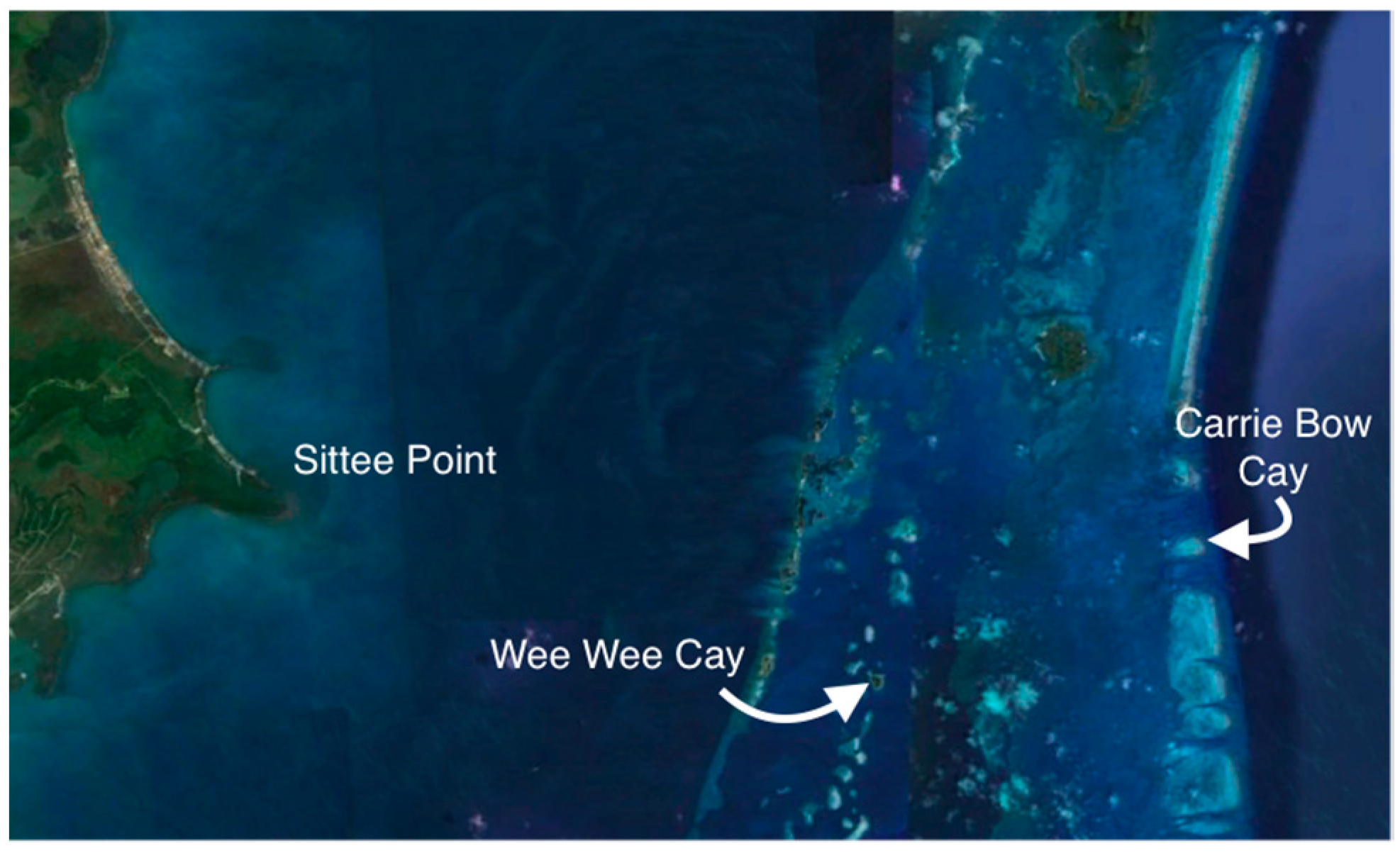
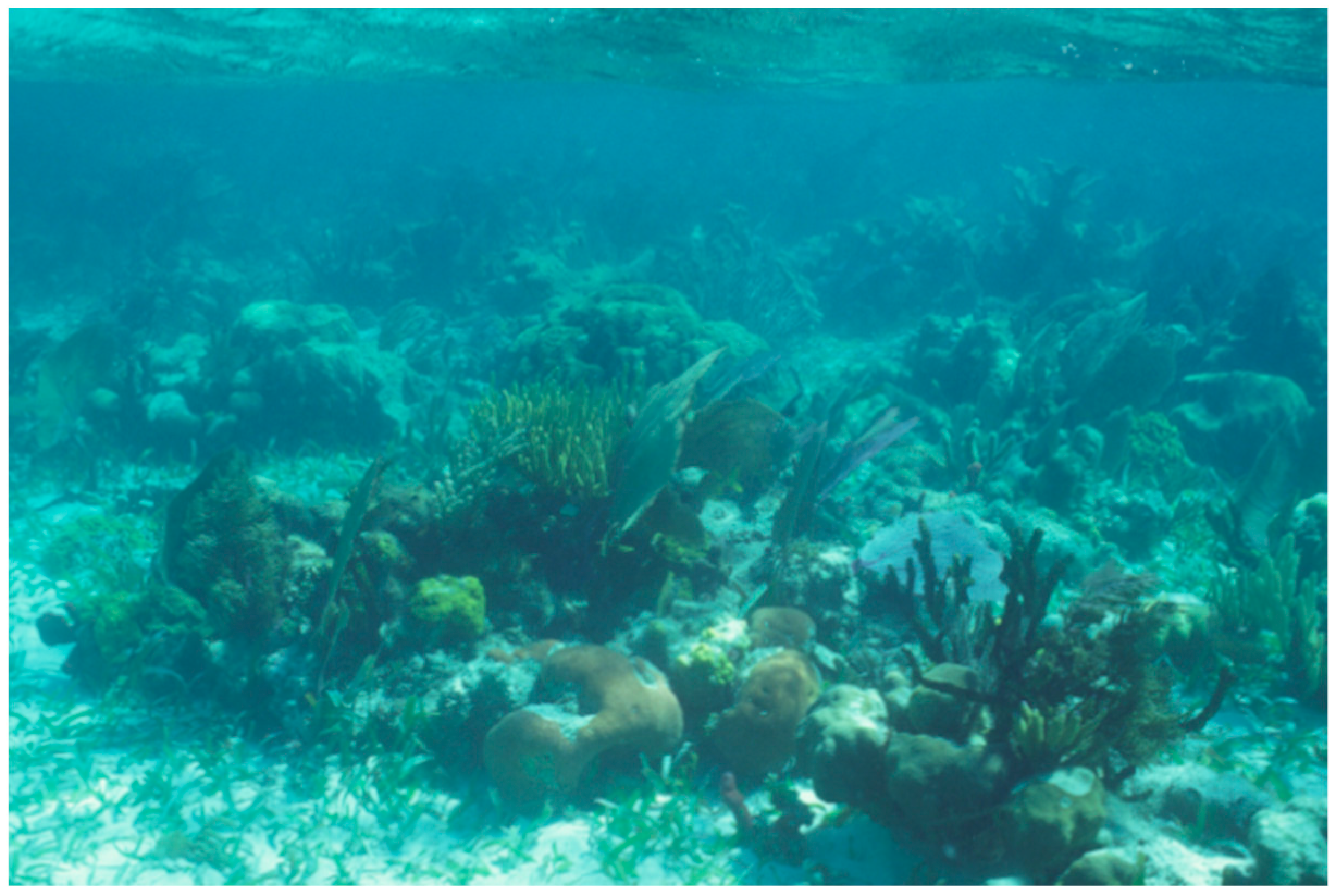
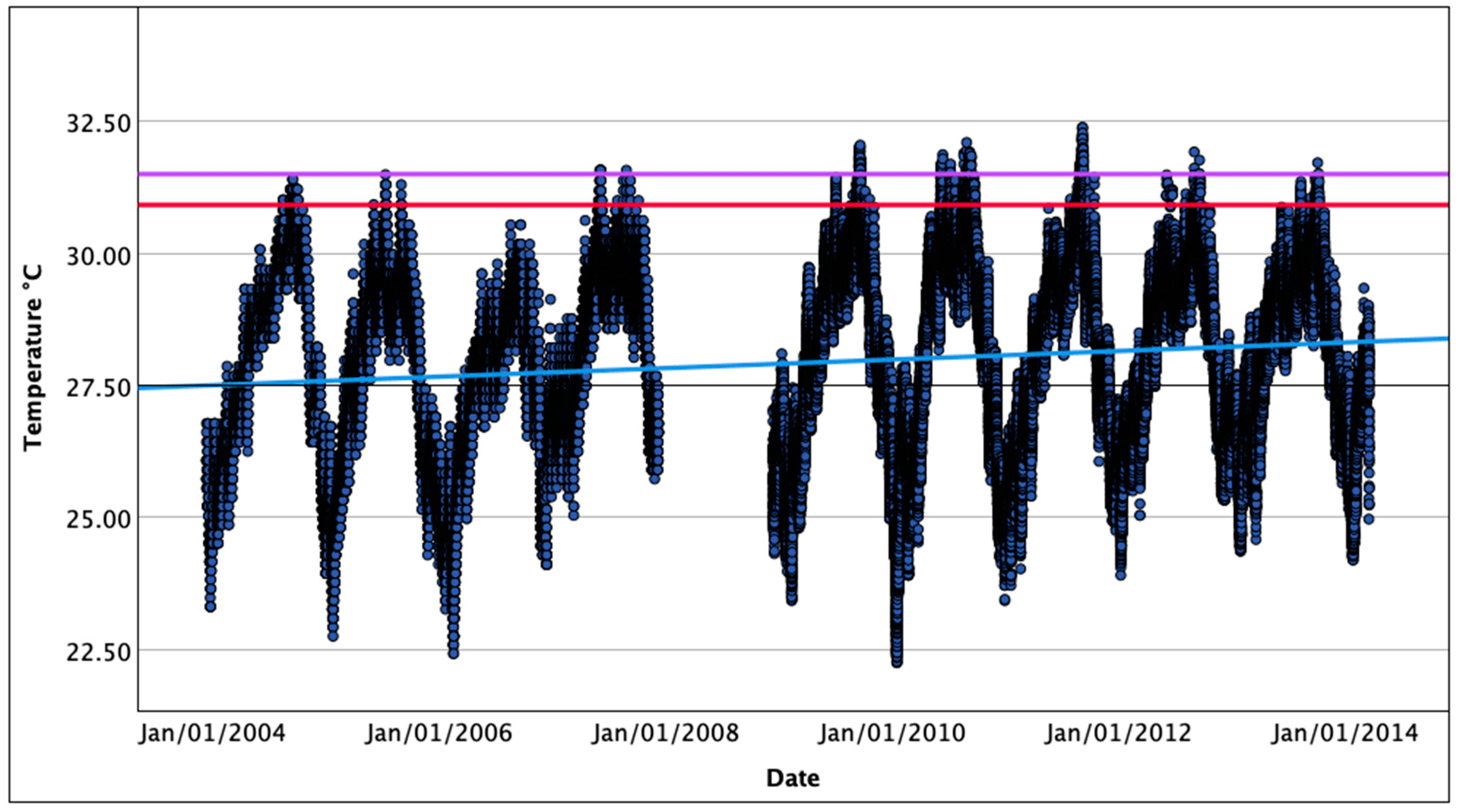
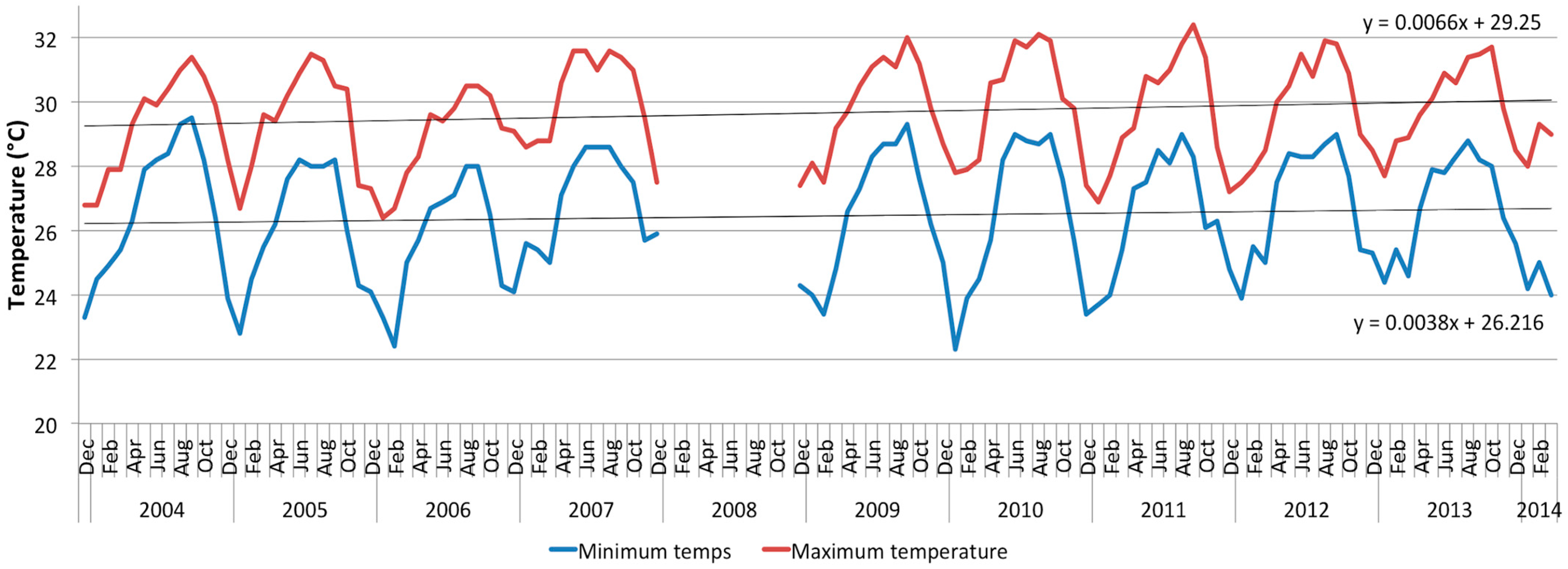




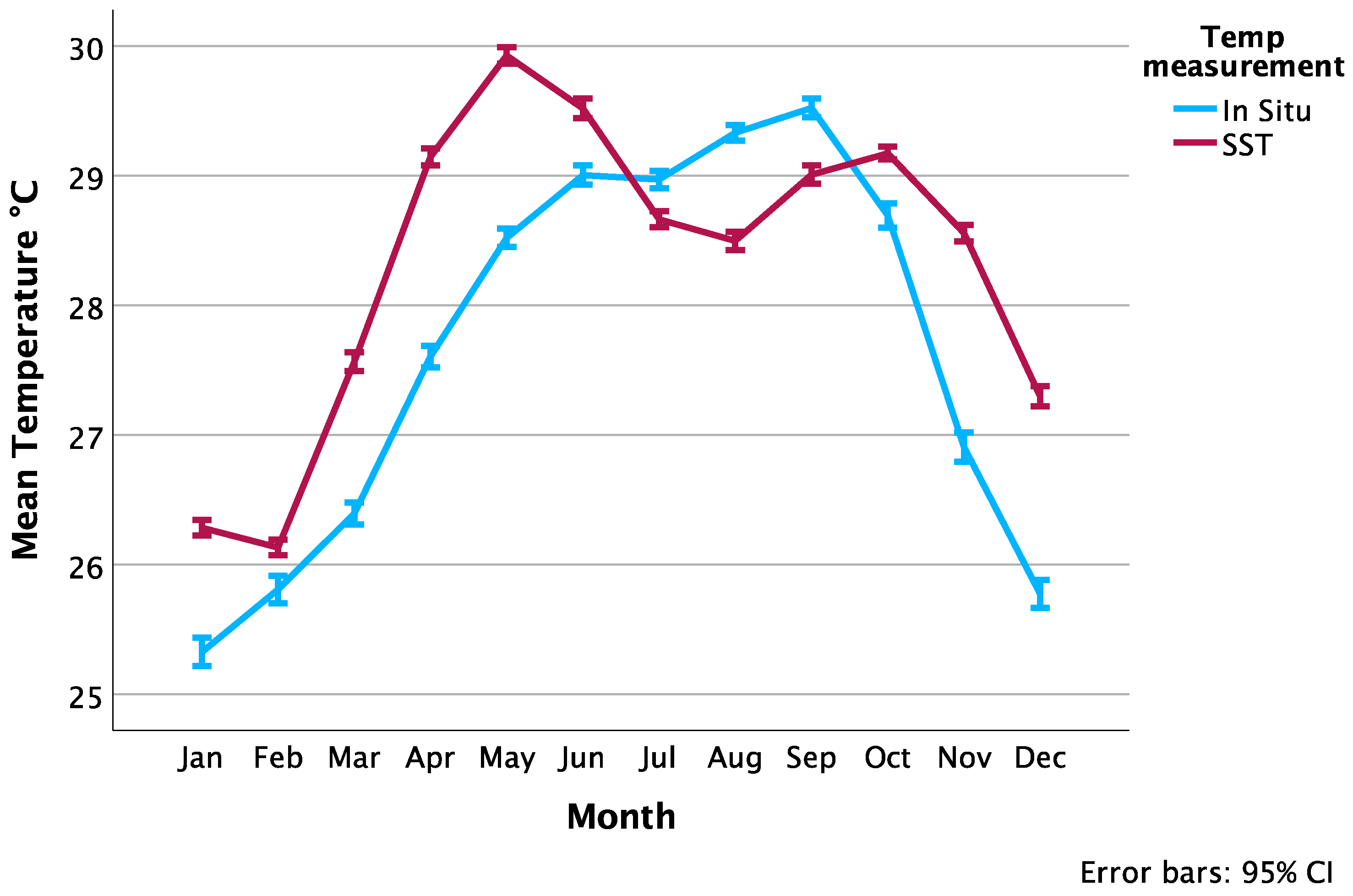

| Year | # Days when Temp Exceeds 31.5 °C | Months with Temp above Threshold | Month with Highest # of Days above Threshold (# Days) |
|---|---|---|---|
| 2004 | 0 | NA | NA |
| 2005 | 0 | NA | NA |
| 2006 | 0 | NA | NA |
| 2007 | 3 | May, Jun., Aug. | 1 each |
| 2009 | 7 | Sep. | Sep. (7) |
| 2010 | 14 | Jun.–Sep. | Sep. (8) |
| 2011 | 12 | Aug., Sep. | Sep. (7) |
| 2012 | 2 | Aug., Sep. | Sep. (1) |
| 2013 | 2 | Oct. | Oct. (2) |
| WWC | sd | Min | Max | Range | CBC | sd | Min | Max | Range | |
|---|---|---|---|---|---|---|---|---|---|---|
| Jan. | 25.59 | 0.54 | 24.5 | 26.8 | 2.3 | 26.18 | 0.79 | 24.4 | 28.8 | 4.5 |
| Feb. | 26.25 | 0.57 | 24.9 | 27.9 | 3.0 | 26.58 | 1.02 | 23.9 | 29.9 | 6.0 |
| Mar. | 26.81 | 0.46 | 25.4 | 27.9 | 2.5 | 26.94 | 0.87 | 25.3 | 29.5 | 4.2 |
| Apr. | 27.77 | 0.67 | 26.3 | 29.3 | 3.0 | 27.91 | 1.26 | 25.4 | 32.3 | 6.9 |
| May | 28.65 | 0.45 | 27.9 | 30.1 | 2.2 | 28.60 | 0.90 | 26.6 | 31.5 | 4.9 |
| Jun. | 28.94 | 0.35 | 28.2 | 29.9 | 1.7 | 29.90 | 0.73 | 27.8 | 31.9 | 4.2 |
| Jul. | 29.26 | 0.44 | 28.4 | 30.4 | 2.0 | 29.31 | 0.91 | 27.8 | 32.6 | 4.8 |
| Aug. | 30.00 | 0.38 | 29.3 | 31.0 | 1.7 | 29.88 | 0.85 | 28.5 | 33.1 | 4.7 |
| Sep. | 30.50 | 0.45 | 29.5 | 31.4 | 1.9 | 30.30 | 0.89 | 28.6 | 33.4 | 4.9 |
| Oct. | 29.73 | 0.51 | 28.2 | 30.8 | 2.6 | 29.64 | 0.75 | 27.7 | 32.0 | 4.3 |
| Nov. | 27.47 | 0.83 | 26.4 | 29.9 | 3.5 | 28.07 | 0.77 | 26.5 | 30.7 | 4.2 |
| Dec. | 25.67 | 0.99 | 23.9 | 28.2 | 4.3 | 26.94 | 1.03 | 22.2 | 29.9 | 7.8 |
| Mean | 28.1 | 0.55 | 26.9 | 29.5 | 2.6 | 28.4 | 0.90 | 26.2 | 31.3 | 5.1 |
| Years | Location | Linear Equation | r2 | Reference |
|---|---|---|---|---|
| 1982–2012 | Intra American Region | 0.0015 only Slope reported | [11] | |
| 1984–2003 | Belize-South | y = 0.0028x + 27.376 | 0.0422 | [12] |
| 1984–2003 | Belize-Glover’s | y = 0.0027x + 27.367 | 0.0379 | [12] |
| 1984–2003 | Belize-North | y = 0.0024x + 27.391 | 0.0325 | [12] |
| 2004–2014 | Belize-Wee Wee Caye | y = 0.0063x + 27.521 | 0.02059 | This study |
Disclaimer/Publisher’s Note: The statements, opinions and data contained in all publications are solely those of the individual author(s) and contributor(s) and not of MDPI and/or the editor(s). MDPI and/or the editor(s) disclaim responsibility for any injury to people or property resulting from any ideas, methods, instructions or products referred to in the content. |
© 2024 by the authors. Licensee MDPI, Basel, Switzerland. This article is an open access article distributed under the terms and conditions of the Creative Commons Attribution (CC BY) license (https://creativecommons.org/licenses/by/4.0/).
Share and Cite
Lobel, P.S.; Lobel, L.K. A Ten-Year Record Shows Warming Inside the Belize Barrier Reef Lagoon. Diversity 2024, 16, 57. https://doi.org/10.3390/d16010057
Lobel PS, Lobel LK. A Ten-Year Record Shows Warming Inside the Belize Barrier Reef Lagoon. Diversity. 2024; 16(1):57. https://doi.org/10.3390/d16010057
Chicago/Turabian StyleLobel, Phillip S., and Lisa Kerr Lobel. 2024. "A Ten-Year Record Shows Warming Inside the Belize Barrier Reef Lagoon" Diversity 16, no. 1: 57. https://doi.org/10.3390/d16010057
APA StyleLobel, P. S., & Lobel, L. K. (2024). A Ten-Year Record Shows Warming Inside the Belize Barrier Reef Lagoon. Diversity, 16(1), 57. https://doi.org/10.3390/d16010057





